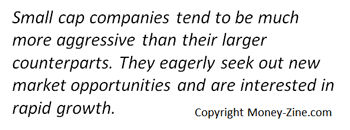The term small cap stock is used to categorize common stocks issued by companies that are considered "small" as measured by their total market capitalization. There is a great deal of investor interest in these securities, because they offer some noteworthy advantages. For example, these stocks can provide investors with growth opportunities that are beyond those of large cap stocks; research studies indicate the return on investment for small cap stocks is oftentimes greater than their larger counterparts.
Small Cap Stocks Defined
| Additional Resources |
| Blue Chip Stocks Dogs of the Dow Penny Stock Stock Market Game |
The total market capitalization of a company is defined as the current market price of a stock times the number of shares outstanding. For example, if Company ABC is selling for $30 per share, and there are 30 million shares outstanding, then the market capitalization of Company ABC is $30 x 30 million shares, or $900 million. Asking ten different investors will likely yield ten different answers as to the exact definition of a small cap stock. The consensus seems to be a total market capitalization of less than $2 billion. Smaller companies with a market cap below $300 million are sometimes referred to as mini or micro-cap stocks. These stocks are too small for this category and best place in the riskier group of Penny Stocks. So our working definition of small cap is a company with market valuation between $300 million and $2 billion.
Advantages
There are some very real advantages that small cap stocks can offer investors that large companies cannot match. Generally, large market capitalization companies, also referred to as blue chip stocks, offer the investor a strong and stable outlook. They are well-established companies that are cautious both operationally and strategically. These attributes make it difficult for large companies to grow rapidly.

Small cap companies tend to be much more aggressive than their larger counterparts. They eagerly seek out new market opportunities, and are interested in rapid growth. This is usually easier for them to accomplish because they may be offering a product or service unlike those existing in the current marketplace. In return, this allows small cap companies to grow more rapidly than larger companies, and these benefits flow to their investors.
Disadvantages
One of the disadvantages of a small cap stock has to do with dividends. Investors looking for a steady stream of income from dividend payments may want to look elsewhere. Many small cap stocks do not offer dividends to investors; instead they use their excess earnings to fuel their rapid growth. Unfortunately, the aggressive growth goals of these companies don't always materialize. The same market expectations that will drive the price of a small cap's stock upwards, will also drive it right back down. This makes their stock prices much more volatile relative to larger companies. If the investor has the risk tolerance for price volatility and the lack of dividends, then they can be often rewarded with higher returns from this class of stock.
Small Cap Stock Theory
Many investors are intrigued with the prospects of higher returns promised by small cap stocks. The theories of greater returns are not just anecdotal in nature, but backed by a study conducted in 1981. In his work, The Relationship Between Return and Market Value of Common Stock, Rolf Banz discovered empirical evidence that smaller companies consistently realized greater overall returns for their shareholders than their larger counterparts. Specifically, Banz found by examining several decades' worth of stock information there was an inverse relationship between the size of the company and the stock's total return to shareholders.
Investment Opportunities
Smaller companies are simply more focused on gaining market share than larger companies. In fact, some large companies have difficulty finding suitable investment opportunities, and return a larger proportion of earnings back to shareholders in the form of stock dividends. On the other hand, small cap companies will often take their earnings and reinvest the money right back into their business. Small businesses are often much leaner organizations, being thriftier with the money they have at their disposal (learn more about small businesses statistics). While many larger companies may be flying their executives around the country in private jets and helicopters, this would be an unusual expense for a small cap company.
Historical Stock Returns
To put this small cap theory to test, we've decided to pull some information from Morningstar to compare the three and five year returns on large, medium and small cap stocks. As of September 2008, the below table contains total returns for each of these types of mutual funds:
| Stock Fund | 3 Year Return | 5 Year Return |
| Large Growth | -0.17% | 1.40% |
| Medium Growth | 3.62% | 8.72% |
| Small Growth | 2.51% | 6.11% |
| Large Core | 4.09% | 6.88% |
| Medium Core | 1.45% | 8.15% |
| Small Core | 2.83% | 9.09% |
| Large Value | -0.07% | 6.57% |
| Medium Value | 0.32% | 9.04% |
| Small Value | 2.30% | 9.24% |
The above table demonstrates the five-year historical returns for small cap stocks are greater than that of large-cap stocks. In fact, large cap stocks have lower rates of return than those of either mid or small cap stocks in all possible comparisons. In the shorter-term view (3 Year Return), we do see indications that large cap stocks are starting to outpace the growth of smaller companies. This fact could be attributed to the downturn in the economy, which might prompt some investors to switch back to safer investments (larger companies).
About the Author - Small Cap Stocks




.jpg)